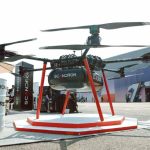Skyport: The live fish and seafood air transport expert
“Live fish is a sensitive cargo and stringent processes must be adhered to at every stage of the transportation process. The fish will be loaded into special vessels for transport in boxes, and these are carefully placed inside further unit load devices for their journey. As well as maintaining constant environmental conditions specific to the species’ requirements, timing is critical, as the entire journey must not exceed 48 hours.” – David Adamek, CEO of Skyport
By Ayesha Rashid
Live fish transportation is a rapidly growing segment of the air cargo industry amid growing demand for fresh fish and seafood around the world. While live fish transportation poses some challenges, it is generally considered to be safe and efficient.
Live fish are considered to be sensitive cargo because they are alive and need to be kept alive during transport. This means that the cargo must be handled with care and that the transportation process must be closely monitored. There are a few different methods of live fish transportation, each of which has its own advantages and disadvantages. New technologies and practices have also been developed to reduce stress on fish and keep them healthy during transit.
In this article, we will take a closer look at live fish transportation, including the challenges and benefits of this type of air transportation with David Adamek, CEO of Skyport.
Sensitive cargo
The transportation of live fish is a delicate and time-sensitive operation that requires the strictest environmental conditions to be maintained at all times. Special vessels are used for this type of cargo, and they are equipped with the necessary facilities to ensure that the fish are kept alive and in good condition during the journey.
The guidelines for live fish transportation are set by the International Air Transport Association (IATA). The IATA Live Animals Regulations (LAR) are the only international standards for the shipment of live animals by air.
The LAR provides guidance on the preparation of live animals for transport, the handling of live animals during transport, and the transportation of live animals in special containers. The LAR is revised every two years to keep up with the latest advancements in science and technology.
“The IATA Live Animals Regulations (LAR) contains a comprehensive classification of thousands of animal species along with the container specifications required for their transport.
“Specific regulations apply according to the species of fish – some fish must be individually packed due to their sensitive reactions or aggressive tendencies. Seahorses can be shipped in plastic bags as long as they can anchor themselves to something in order to minimize stress. Jellyfish, for instance, can be shipped but to prevent air getting under the umbrella the bags must not contain any free air/oxygen, as this will jeopardize the well-being and survival rates of the jellyfish
“Live fish is a sensitive cargo and stringent processes must be adhered to at every stage of the transportation process. The fish will be loaded into special vessels for transport in boxes, and these are carefully placed inside further unit load devices for their journey. As well as maintaining constant environmental conditions specific to the species’ requirements, timing is critical, as the entire journey must not exceed 48 hours,” says Adamek.
Other main challenges of live fish transportation are keeping the water at a constant temperature and ensuring that the fish have enough oxygen to breathe. These challenges are compounded by the fact that fish are highly sensitive to changes in their environment and can easily succumb to stress.
Despite the challenges, live fish transportation is a necessary part of the seafood industry.
Temperature requirement
Shipments of live fish are viewed as perishable items, so the entire route must not take more than 48 hours. Time is extremely essential when it comes to fish.
“We manage a great diversity of live animals every day at Skyport, both big and small. The most challenging was probably the shipment of five black rhinos from Prague airport to Rwanda. We closed off our warehouse for three hours and all our staff on duty were carefully securing the huge containers so that the rhinos could be loaded on board safely,” said Adamek.
The specific temperate requirements for different fish species can vary significantly, making transportation via aircraft a challenge. Maintaining optimal temperatures during transit is essential to ensure the fish arrive alive and in good condition. Choosing the right aircraft, and outfitting it with the proper temperature-control equipment, is critical to making sure fish arrive at their destination safely.
Transporting fish by aircraft requires specific temperature requirements in order to ensure the safety and quality of the fish. The optimal temperate for fish transportation is between 0 and 4 degrees Celsius. Fish that are transported at too high of a temperate can experience decreased quality, while those transported at too low of a temperate can experience increased mortality rates.
“Live tropical fish (AVF) must not be stored under a minimum temperature of 20 C (68 F) during ground time. Transportation to and from the aircraft must be performed as quickly as possible. The optimal temperature during transportation lies between 20 °C and 27 °C.
“The fish must first undergo a veterinary check at the country of origin prior to being tendered for transport by air. It is important to ensure that the fish are then held in areas where the ambient temperature remains moderate and stable, ensuring there are no extremes or excursions in temperature during both the ground handling process and when the fish are in transit while on board the aircraft. The consignee arranges immediate collection of the fish upon arrival to undergo another veterinary examination and approval.”
Training provided to handlers
Air transport is the most humane way of transporting live animals on long journeys. It is imperative that high standards are maintained by all those involved: veterinary inspectors, animal keepers, container manufacturers, ground handlers, air carriers, and so on.
In order to ensure the safety and well-being of the animals, specific handling is required for each of the animal species, such as constant temperatures throughout the journey, sufficient feeding or fasting prior to travel. Therefore, for long journeys the only speedy option is to use an aircraft.
Fish handlers are trained to handle fish in a safe and humane manner. The handlers of fish must be trained in order to ensure that the fish are properly cared for. This training includes how to properly feed the fish, clean the fish tanks, and maintain the water quality. The handlers must also be trained in how to identify signs of stress and illness in the fish, so that they can be quickly treated.
“The well-being of the fish we take in is always our top priority. Our staff are highly trained and experienced in checking all documents as well as the conditions of the animals and their transport boxes. We have a designated room in our warehouse facility which is fitted with air conditioning and temperature settings that can be adjusted to suit all types of animals, including direct heating if needed, such as when housing reptiles.
“Skyport provides on-demand veterinary services for live animals. The service is typically requested by shippers for animals in transit via our station, where a professional veterinarian will come and assess the animal’s health,” Adamek further explains.
Skyport transports all sorts of freshwater tropical fish, marine fish and aquarium plants. One of the most widely distributed tropical fish is the Guppy.
“We have moved all different varieties including, but not limited to, the Green Cobra, Velvet White, Neon Red, Tuxedo Dragon Head and Sunset Guppy. These are usually destined to be domestic pets.”
Technological advancement
It is imperative that the live fish are properly packaged before dispatch, in a single species per strong plastic bag, a minimum of one-quarter filled with water. The rest of the container should then be filled with oxygen. The shipper is responsible for this. The sealed bag is to be placed in a polystyrene or fibreboard container, with insulation based on the temperature difference of the origin and destination locations.
The containers are then labeled stating the species, required temperature and handling, and also indicating the date and local time of packaging the fish.
“Technology is already benefiting the process in the form of temperate monitoring and regulating but I don’t think the transport of live tropical fish will change much in the future.
“Undoubtedly, technology promises to bring vast benefits to the air cargo sector more broadly but in the niche area of live fish transportation there are certain process that can’t be digitalised or simplified with the introduction of more technology – at least not any time soon.”
Effects of Covid-19
The novel coronavirus (Covid 19) has had a significant impact on the global economy, with businesses and supply chains being disrupted on a scale not seen since the Second World War. The fishing industry has also been affected, with the transport of fish and seafood being disrupted by the pandemic.
The decrease in demand for fish has been most keenly felt in China, which is the world’s largest importer of seafood. The Chinese market accounts for around a third of the global demand for fish, and the pandemic has seen a sharp drop-off in demand from Chinese consumers. This has had a knock-on effect on other markets. However that was not the case with Skyport.
“Covid has not particularly affected the process or business of transporting fish. During the pandemic we have been handling about ten shipments of tropical fish a month, each shipment counting approximately 45 boxes of fish, which is similar volume as in the years prior to Covid-19.
“At Skyport, we have always specialized in the import of tropical fish. Our main supplier countries are Indonesia, Malaysia and Sri Lanka, and we work closely with tropical fish wholesalers based in the Czech Republic. We have built up strong relationships with our suppliers, and are able to source the highest quality fish at the most competitive prices. Our tropical fish are Healthy and vibrant and are sure to brighten up any home aquarium.”















